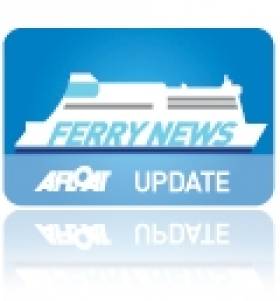Displaying items by tag: Ulysses overhaul
Irish Ferries main vessel on the Dublin-Holyhead route, Ulysses is receiving an annual overhaul but for the first time at A&P Tyne on the North Sea, which has the largest dry-dock on the east coast of England, writes Jehan Ashmore.
The 2001 Aker Finnyards built cruise-ferry of 50,398 gross tonnes is undergoing the dry-docking at one of the three facilities that form the A&P Group, the others been located at Tees and Falmouth.
When combined the facilities have seven dry-docks in the Group which is part of the wider APCL Group of shipbuilders and shiprepairers, among them Cammell Laird, Birkenhead on the west coast (as reported yesterday). In recent year's collaboration has seen A&P Tyne fabricate modular blocks for the UK's polar research vessel, RRS Sir David Attenborough which was launched from the Merseyside shipyard.
As for the dry-dock programme of the 209m Ulysses, the cruise-ferry which arrived in the first week of this month, Afloat has tracked to the 236m Dry-Dock downriver of Newcastle-upon-Tyne.
Among the works, is the overhaul of the main engine starboard gearbox. Such work will require the creation of a technical opening through the ferry’s deck, this is to facilitate the team to lift heavier items from the engine room and then be transported to the engineering workshop.
The team at the A&P yard at Hebburn, Tyne & Wear, is also carrying out CPP blade seal replacements on both sets of the vessel’s propellers. In addition to rudder-clearances, rudder beck flap renewals, the overhaul of flap-hinges, tail-shaft wear-downs and an overhaul of the steering gear.
Also A&P have been tasked in the removal of life-boats, life-rafts and the Marine Evacuation Systems that will all require servicing.
Ulysses Heads for Merseyside for Annual Overhaul
#UlyssesOverhaul – Ulysses, Irish Ferries main Dublin-Holyhead route cruiseferry since entering service in 2001, is understood to be heading tonight for Birkenhead on Merseyside for annual overhaul, writes Jehan Ashmore.
Taking her sailing roster is Isle of Inishmore which last month was transferred from Rosslare-Pembroke duties and entered service on the Dublin Port route to provide additional capacity over Christmas and early New Year periods.
At this quieter time of year, the winter dry-docking of Ulysses and majority of fleetmates are to take place at Cammell Laird, the shipyard and engineering repair providers. In addition to Isle of Inishmore, the Dublin-Holyhead route will be maintained by regular vessels, fast-ferry Jonathan Swift and ro-pax Epsilon.
As Stena Line decided to cancel Dun Laoghaire-Holyhead sailings over the festive period, the route last operated by HSS Stena Explorer until the main summer season ceased in September, leaves Jonathan Swift as the sole fast-ferry running on a year-round Irish Sea service.
On completion of overhauling Ulysses which will be carried out in dry-dock No. 5, Isle of Inishmore and Jonathan Swift are also scheduled to visit the dry-dock facility later this month.





























































